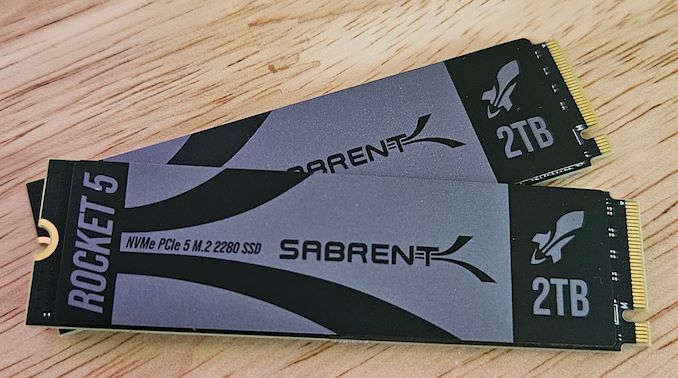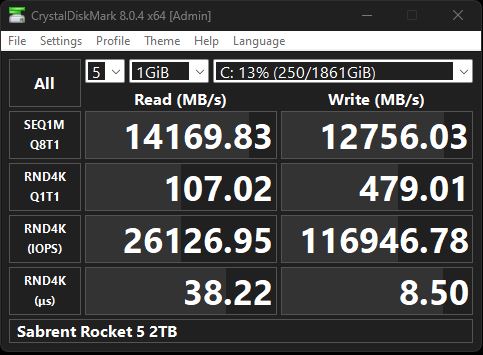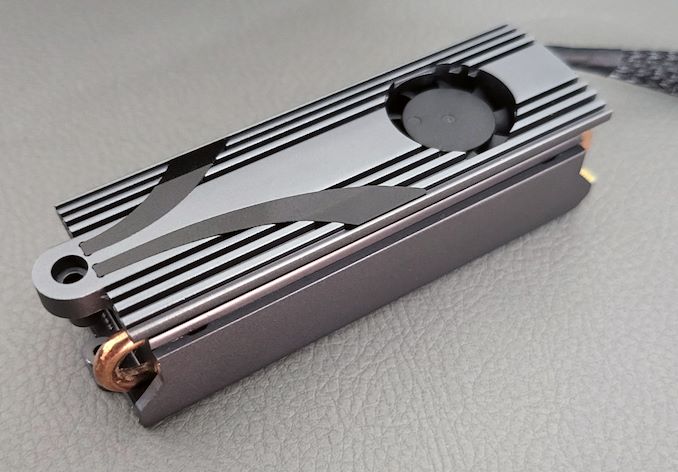Sabrent's Rocket 5 SSD Rockets to 14,169 MB/s, Available Soon
by Anton Shilov on January 8, 2024 8:00 AM EST
Sabrent on Friday announced the latest addition to its Rocket family of high-performance SSDs, the Rocket 5. Rated for sequential read speeds of over 14,000 MB/s and up to 1.4 million of random read/write IOPS, the drive is slated to be the fastest Phison-powered PCIe 5.0 drive released thus far. The Rocket 5 will work with regular coolers provided by motherboards, but will also come bundled with a sizable cooling system featuring a heat pipe and a fan.
Today's high-end PCIe Gen5 SSDs based on the Phison PS5026-E26 controller typically offer maximum sequential read speeds of 10 to 12 GB/second, depending on the generation of NAND used with the powerful controller. Initial drives were paired with 1600 MT/sec NAND, while more recent drives have been paired with 2000 MT/sec NAND. But with 2400 MT/sec NAND finally becoming available, Sabrent has been working with Phison to push the limit of what their controller can do, and finally come close to saturating the nearly 16GB/second PCIe 5.0 x4 interface.
So Sabrent went on to a mission to build a Phison E26-based SSD that could fully utilize a PCIe 5.0 x4 interface. The company first outlined plans to build a drive sequential read speed of over 14,000 MB/s in March last year and then demonstrated an SSD that could hit 14,179 MB/s in July. Hitting a particular performance level in a lab is one thing, but making a reliable storage product that consistently hits such a speed and does not cost an arm and a leg is another, so the company said it would take it a while to make its Rocket 5 a commercial product.
The scarce availability of fast 3D NAND has been the most critical bottleneck, with Sabrent (and other drive makers) waiting on Micron and others to begin shipping 2400 MT/sec TLC NAND in high volumes – which is now finally happening.
On Friday, Sabrent finally introduced its Rocket 5 family, which will consist of three models: initial 1 TB and 2 TB models, while a 4 TB model will come later. The higher-end 2 TB and 4 TB drives will offer a sequential read speed of up to 14,000 MB/s and a sequential write speed of up to 12,000 MB/s, as well as a random read/write performance of 1.4 million IOPS. The 1 TB model will be slightly slower due to lower level of parallelism, but it will still be measurably faster than many of the drives featuring a PCIe Gen5 x4 interface available today.
Interestingly, by peak performance of range-topping Rocket 5 drives is shown at 14,169 MB/s for reads and 12,756 MB/s for writes. Perhaps, some additional firmware tweaks will ensure even higher performance than Sabrent lists today, though we will see about that.
The company says that the Sabrent Rocket 5 drives will run just fine with heatsinks offered by high-end motherboards. Though for systems that for some reason do not come with pre-built heatsinks, Sabrent will bundle a rather sizable active cooler as well, for customers who need better cooling or just intend to beat on the drive with very long sustained writes.
Sabrent has not yet announced the pricing of its Rocket 5 drives. Though with TLC NAND prices currently on an upswing – never mind the high-end TLC Sabrent's drive will need to use – it's not too surprising to see drive manufacturers cautious about announcing drive pricing before anything is actually shipping.
Source: Sabrent Press Release













8 Comments
View All Comments
TheinsanegamerN - Monday, January 8, 2024 - link
Speedipus rex.I've been pleased with my rocket 4 plus, and it's nice there is an 8TB version of that drive. I hope they are not letting 8TB fall to the wayside permanently on PCIE 5.
shabby - Monday, January 8, 2024 - link
What's the purpose of these drives? As an os drive there's no decrease in boot times, as a gaming drive there's no decrease in load times. Only benefit is copying large files to another drive that's just as fast 🤷🏼♂️Samus - Tuesday, January 9, 2024 - link
Bragging rights.FunBunny2 - Tuesday, January 9, 2024 - link
"What's the purpose of these drives? "5NF really, truly relational databases?? Yeah that olde idea, but not as old hierarchy and flat files again in vogue.
Gothmoth - Monday, January 29, 2024 - link
makes loading and switching huge stable diffusion models a breeze. i love my gen5 ssd drives.Gothmoth - Monday, January 29, 2024 - link
you think everyone is a gamer? when you really don´t see for what the drives are great you are not in a position to talk about it in a belittling way. i would just ask instead "what is the use for these drives" not come to conclusions with little to no experience beside OS load times and game level load times... ;)ballsystemlord - Wednesday, January 10, 2024 - link
At some point in time, much like QLC, even TLC will hit limits for how fast it can transfer the data from the SLC cache into the final storage method (QLC or TLC).It would be interesting to test if this drive hits those limits.
Gothmoth - Monday, January 29, 2024 - link
i need 128-256GB of ram in my system because i work with video files, AI models and 3D scenes. the data is in all these cases huge. AI models can be dozend of GB. even the smaller stable diffusion models are often 6-12 GB. to load this data into ram, vram my SSD´s can´t be fast enough. i only hope to see more capacity.